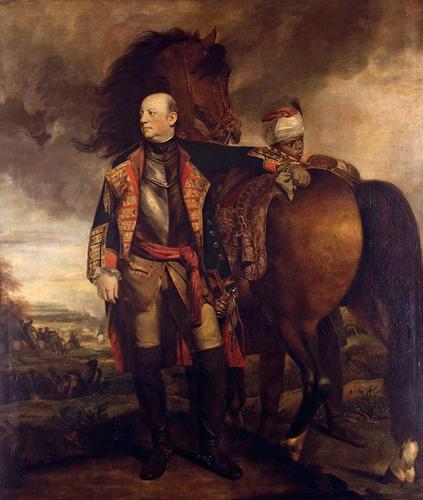-
1 of 253523 objects
John Manners, Marquess of Granby (1721-70) and a Groom c.1766-70
Oil on canvas | 245.5 x 207.0 cm (support, canvas/panel/stretcher external) | RCIN 405894

Sir Joshua Reynolds (1723-92)
John Manners, Marquess of Granby (1721-70) c.1766-70
-
Commander-in-Chief of the British forces during the Seven Years’ War, John Manners, Marquess of Granby wears the uniform of a Colonel of the Royal Horse Guards (known as the ‘Blues’), to which he was appointed by King George II in 1758. Reynolds uses a low perspective to emphasise the heroic monumentality of his subject, who stands against a smoke-filled sky as the action continues in the distance.
Paired with a portrait of Count of Schaumburg-Lippe (1724-77), Commander of Artillery under the allied forces of Prince Ferdinand of Brunswick (RCIN 405893), this work was commissioned by George Townshend, 1st Marquess Townshend (1724-1807), who served under both men during the conflict.
The setting is thought to be the Battle of Vellinghausen, 15-16 July 1761, where Manners and Townshend both served. However, Manners is depicted with a bare head, which suggests it may be the Battle of Warburg in Westphalia, which took place a year earlier, and where he gained notoriety for losing his hat and wig during the charge.
Manners is accompanied by a groom, who stands to the far side of his bay horse. Many free and enslaved Black men served in the British army during the Seven Years’ War. However, Reynolds’s pupil and biographer James Northcote records that this figure was modelled on the artist’s own servant. Neither Reynolds nor Northcote document the name of the artist’s footman and his identity remains unknown to us today. During the eighteenth century, attendants of African descent often featured within portraits of European sitters as a visual trope to convey the wealth and status of the European sitter.
As the leading portraitist of the age, Reynolds gained recognition under George III, receiving a knighthood, being appointed the first president of the Royal Academy and Principal Painter to the King upon Ramsay’s death in 1784. Despite this, he never received a commission. The fact that the Royal Collection holds a significant group of paintings by this leading eighteenth-century portraitist is entirely thanks to the patronage and collecting of George IV.
The work was presented to George IV by Townshend’s widow in 1810. It hung in the Crimson Drawing Room at Carlton House, George IV’s residence on Pall Mall, before being transferred to St James’s Palace in 1830.
Provenance
One of a pair (RCIN 405893-4) presented to George IV by Lady Townsend in 1810; recorded hanging in the Crimson Drawing Room at Carlton House in 1819 (no 9); sent to St James's Palace in 1830
-
Medium and techniques
Oil on canvas
Measurements
245.5 x 207.0 cm (support, canvas/panel/stretcher external)
286.2 x 248.1 x 16.5 cm (frame, external)
Category
Object type(s)
Other number(s)
Alternative title(s)
John Manners, Marquess of Granby (1721-70)